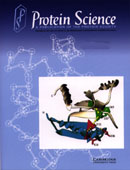Crossref Citations
This article has been cited by the following publications. This list is generated based on data provided by
Crossref.
Tito, Paula
Nettleton, Ewan J
and
Robinson, Carol V
2000.
Dissecting the hydrogen exchange properties of insulin under amyloid fibril forming conditions: a site-specific investigation by mass spectrometry.
Journal of Molecular Biology,
Vol. 303,
Issue. 2,
p.
267.
Nettleton, Ewan J.
Tito, Paula
Sunde, Margaret
Bouchard, Mario
Dobson, Christopher M.
and
Robinson, Carol V.
2000.
Characterization of the Oligomeric States of Insulin in Self-Assembly and Amyloid Fibril Formation by Mass Spectrometry.
Biophysical Journal,
Vol. 79,
Issue. 2,
p.
1053.
MacPhee, Cait E.
and
Dobson, Christopher M.
2000.
Formation of Mixed Fibrils Demonstrates the Generic Nature and Potential Utility of Amyloid Nanostructures.
Journal of the American Chemical Society,
Vol. 122,
Issue. 51,
p.
12707.
Bevivino, Anthony E.
and
Loll, Patrick J.
2001.
An expanded glutamine repeat destabilizes native ataxin-3 structure and mediates formation of parallel β-fibrils.
Proceedings of the National Academy of Sciences,
Vol. 98,
Issue. 21,
p.
11955.
Zurdo, Jesús
Guijarro, J. Iñaki
and
Dobson, Christopher M.
2001.
Preparation and Characterization of Purified Amyloid Fibrils.
Journal of the American Chemical Society,
Vol. 123,
Issue. 33,
p.
8141.
Zurdo, Jesús
Guijarro, J.I
Jiménez, Jose L
Saibil, Helen R
and
Dobson, Christopher M
2001.
Dependence on solution conditions of aggregation and amyloid formation by an SH3 domain.
Journal of Molecular Biology,
Vol. 311,
Issue. 2,
p.
325.
Smith, David P.
and
Radford, Sheena E.
2001.
Role of the single disulphide bond of β2‐microglobulin in amyloidosis in vitro.
Protein Science,
Vol. 10,
Issue. 9,
p.
1775.
Kirkitadze, Marina D
Condron, Margaret M
and
Teplow, David B
2001.
Identification and characterization of key kinetic intermediates in amyloid β-protein fibrillogenesis11Edited by F. Cohen.
Journal of Molecular Biology,
Vol. 312,
Issue. 5,
p.
1103.
Blanco, Francisco J
Hess, Sonja
Pannell, Lewis K
Rizzo, Nancy W
and
Tycko, Robert
2001.
Solid-state NMR data support a helix-loop-helix structural model for the N-terminal half of HIV-1 rev in fibrillar form.
Journal of Molecular Biology,
Vol. 313,
Issue. 4,
p.
845.
Eva, Žerovnik
2002.
Amyloid‐fibril formation.
European Journal of Biochemistry,
Vol. 269,
Issue. 14,
p.
3362.
Xu, Bin
Hua, Qing-xin
Nakagawa, Satoe H.
Jia, Wenhua
Chu, Ying-Chi
Katsoyannis, Panayotis G.
and
Weiss, Michael A.
2002.
Chiral mutagenesis of insulin’s hidden receptor-binding surface: structure of an Allo-isoleucineA2 analogue.
Journal of Molecular Biology,
Vol. 316,
Issue. 3,
p.
435.
Pertinhez, Thelma A
Bouchard, Mario
Smith, Richard A.G
Dobson, Christopher M
and
Smith, Lorna J
2002.
Stimulation and inhibition of fibril formation by a peptide in the presence of different concentrations of SDS.
FEBS Letters,
Vol. 529,
Issue. 2-3,
p.
193.
Jiménez, José L.
Nettleton, Ewan J.
Bouchard, Mario
Robinson, Carol V.
Dobson, Christopher M.
and
Saibil, Helen R.
2002.
The protofilament structure of insulin amyloid fibrils.
Proceedings of the National Academy of Sciences,
Vol. 99,
Issue. 14,
p.
9196.
Liu, Xiaoda
Kaczmarski, Krzysztof
Cavazzini, Alberto
Szabelski, Pawel
Zhou, Dongmei
and
Guiochon, Georges
2002.
Modeling of Preparative Reversed‐Phase HPLC of Insulin.
Biotechnology Progress,
Vol. 18,
Issue. 4,
p.
796.
Xu, Bin
Hua, Qing‐Xin
Nakagawa, Satoe H.
Jia, Wenhua
Chu, Ying‐Chi
Katsoyannis, Panayotis G.
and
Weiss, Michael A.
2002.
A cavity‐forming mutation in insulin induces segmental unfolding of a surrounding α‐helix.
Protein Science,
Vol. 11,
Issue. 1,
p.
104.
Srisailam, Sampath
Kumar, Thallampuranam Krishnaswamy S.
Rajalingam, Dakshinamurthy
Kathir, Karuppanan Muthusamy
Sheu, Hwo-Shuenn
Jan, Fuh-Jyh
Chao, Pei-Chi
and
Yu, Chin
2003.
Amyloid-like Fibril Formation in an All β-Barrel Protein.
Journal of Biological Chemistry,
Vol. 278,
Issue. 20,
p.
17701.
Srinivasan, Rekha
Jones, Eric M.
Liu, Keqian
Ghiso, Jorge
Marchant, Roger E.
and
Zagorski, Michael G.
2003.
pH-Dependent Amyloid and Protofibril Formation by the ABri Peptide of Familial British Dementia.
Journal of Molecular Biology,
Vol. 333,
Issue. 5,
p.
1003.
Dong, Jian
Wan, Zhuli
Popov, Maxim
Carey, Paul R.
and
Weiss, Michael A.
2003.
Insulin Assembly Damps Conformational Fluctuations: Raman Analysis of Amide I Linewidths in Native States and Fibrils.
Journal of Molecular Biology,
Vol. 330,
Issue. 2,
p.
431.
Necula, Mihaela
Chirita, Carmen N.
and
Kuret, Jeff
2003.
Rapid Anionic Micelle-mediated α-Synuclein Fibrillization in Vitro.
Journal of Biological Chemistry,
Vol. 278,
Issue. 47,
p.
46674.
Tiyaboonchai, Waree
Woiszwillo, James
Sims, Robert C
and
Middaugh, C.Russell
2003.
Insulin containing polyethylenimine–dextran sulfate nanoparticles.
International Journal of Pharmaceutics,
Vol. 255,
Issue. 1-2,
p.
139.

